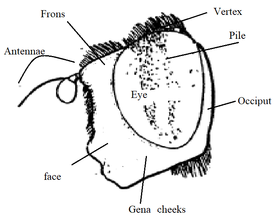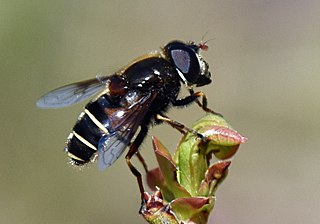
Eristalis cryptarum is a holarctic species of hoverfly. Known as the bog hoverfly or bog-dwelling drone fly, it is a bog specialist but may occur in other wetlands. Its larvae are assumed to live in peat that is saturated with water, such as that found in these boggy areas. The female has been observed depositing eggs on and close to very fresh cow dung along oligotrophic seepages in moorland.

Brachyopa flavescens, The Yellow Sapeater, is a fairly common species of syrphid fly. It has been observed in northeastern North America. Hoverflies get their names from the ability to remain nearly motionless while in flight. The adults are also known as flower flies for they are commonly found around and on flowers, from which they get both energy-giving nectar and protein-rich pollen. Larvae for this genus are of the rat-tailed type. B.flavescens larvae have not been described.
Blera nigra , the golden-haired wood fly, is a fairly common species of syrphid fly first officially described by Williston in 1887 Hoverflies get their name from the ability to remain nearly motionless while in flight The adults are also known as flower flies for they are commonly found around and on flowers from which they get both energy-giving nectar and protein rich pollen. The larvae are of the rat-tailed type feeding on exuding sap or in the rot holes of trees.

Meromacrus acutus, the Carolinian elegant, is a species of syrphid fly in the family Syrphidae. This uncommon species is distributed in the Eastern United States and South America. Notable for the black and yellow pattern mimicking wasps. Hoverflies get their names from the ability to remain nearly motionless while in flight. The adults are also known as flower flies for they are commonly found around and on flowers, from which they get both energy-giving nectar and protein-rich pollen. The larvae are aquatic filter-feeders of the rat-tailed type. They are found in rot holes of trees.
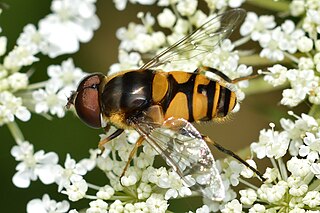
Eristalis transversa, the transverse banded drone fly, is a common species of syrphid fly first officially described by Wiedemann in 1830. Hoverflies get their names from the ability to remain nearly motionless while in flight. The adults are also known as flower flies for they are commonly found around and on flowers, from which they get both energy-giving nectar and protein-rich pollen. The larvae are rat-tailed type but larvae of this specific species has not been reported.

Blera badia, the Common Wood Fly, is a common species of syrphid fly first officially described by Walker in 1849. Hoverflies get their names from the ability to remain nearly motionless while in flight. The adults are also known as flower flies, for they are commonly found around and on flowers, from which they get both energy-giving nectar and protein-rich pollen. The larvae are of the rat-tailed type, feeding on exuding sap or in the rot holes of trees.

Blera umbratilis, the hairy wood fly, is an uncommon species of syrphid fly first officially described by Williston in 1887. Hoverflies get their names from the ability to remain nearly motionless while in flight. The adults are also known as flower flies for they are commonly found around and on flowers, from which they get both energy-giving nectar and protein-rich pollen. The larvae are of the rat-tailed type, feeding on exuding sap or in the rot holes of trees.
Blera armillata, the orange-faced wood fly, is an uncommon species of syrphid fly first officially described by Osten Sacken in 1875. Hoverflies get their names from the ability to remain nearly motionless while in flight. The adults are also known as flower flies for they are commonly found around and on flowers, from which they get both energy-giving nectar and protein-rich pollen. The larvae are of the rat-tailed type, feeding on exuding sap or in the rot holes of trees.
Hadromyia aepalius, the Sterling Quicksilver, is a rare species of syrphid fly found in eastern North America. Hoverflies get their names from the ability to remain nearly motionless while in flight. The adults are also known as flower flies for they are commonly found around and on flowers, from which they get both energy-giving nectar and protein-rich pollen.
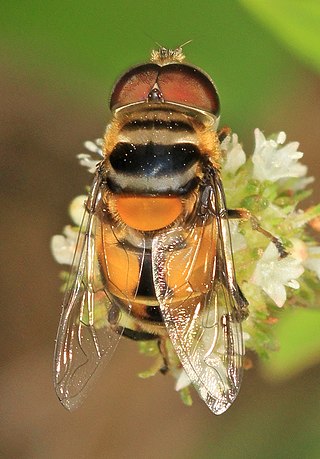
Palpada agrorum, the Double-banded Plushback, is a common species of syrphid fly first officially described by Fabricius in 1787. Hoverflies get their names from the ability to remain nearly motionless while in flight. The adults are also known as flower flies for they are commonly found around and on flowers, from which they get both energy-giving nectar and protein-rich pollen. The larvae are aquatic filter feeders of the rat-tailed type.

Blera pictipes, the painted wood fly, is a rare species of syrphid fly first officially described by Bigot in 1883. Hoverflies get their names from the ability to remain nearly motionless while in flight. The adults are also known as flower flies for they are commonly found around and on flowers, from which they get both energy-giving nectar and protein-rich pollen. The larvae are of the rat-tailed type, feeding on exuding sap or in the rot holes of trees.

Brachyopa daeckei, the black-tailed sapeater, is a rare species of syrphid fly that has been observed in northeastern North America. Hoverflies get their names from the ability to remain nearly motionless while in flight. The adults are also known as flower flies for they are commonly found around and on flowers, from which they get both energy-giving nectar and protein-rich pollen. Larvae for this genus are of the rat-tailed type. B.daeckei larvae have not been described.
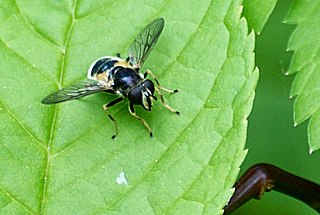
'Blera confusa , the confusing wood fly, is a common species of syrphid fly first officially described by Johnson, 1913 Hoverflies get their names from the ability to remain nearly motionless while in flight. The adults are also known as flower flies for they are commonly found around and on flowers, from which they get both energy-giving nectar and protein-rich pollen. The larvae are of the rat-tailed type feeding on exuding sap or in the rot holes of trees.

Blera robusta, the greenish wood fly, is a rare species of syrphid fly first officially described by Curran in 1922. Hoverflies get this name from the ability to remain nearly motionless while in flight. The adults are also known as flower flies, for they are commonly found around and on the flowers from which they get both energy-giving nectar and protein rich pollen. The larvae are of the rat-tailed type, feeding on exuding sap or in the rot holes of trees.

Blera humeralis, the yellow-legged wood fly, is an uncommon species of syrphid fly officially described by Samuel Wendell Williston in 1882. Hoverflies are so-named for the ability to remain nearly motionless while in flight. The adults are known as flower flies, as they are commonly found around and on flowers from which they get energy-giving nectar and protein-rich pollen. The larvae are of the rat-tailed type, feeding on exuding sap or in the rot holes of trees.
Blera analis, the orange-tailed wood fly, is an uncommon species of syrphid fly. It was officially described by Macquart, 1842. Hoverflies get their names from their ability to remain nearly motionless while in flight. The adults are also known as flower flies for they are commonly found around and on flowers from which they get both energy-giving nectar and protein-rich pollen. The larvae are of the rat-tailed type feeding on exuding sap or in the rot holes of trees.

Palpada albifrons , the White-faced Plushback , is a rare species of syrphid fly observed in from Mexico north-eastward along the coastal areas of the United States. Hoverflies can remain nearly motionless in flight. The adults are also known as flower flies, for they are commonly found on flowers from which they get both energy-giving nectar and protein-rich pollen. The larvae are aquatic.
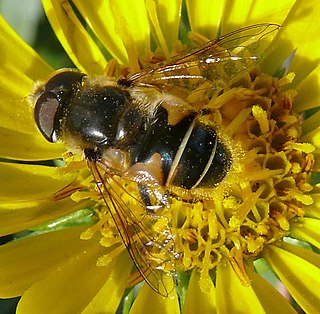
Eristalis hirta, the black-footed drone fly, is a common Western North American species of syrphid fly, first officially described by Loew in 1866. Hoverflies get their names from the ability to remain nearly motionless while in flight. The adults are also known as flower flies as they are commonly found on and around flowers, from which they get both energy-giving nectar and protein-rich pollen. The larvae are aquatic filter-feeders of the rat-tailed type.
Blera metcalfi, Metcalf's wood fly, is a rare species of syrphid fly first officially described by Curran in 1925 Hoverflies get their name from the ability to remain nearly motionless while in flight. The adults are also known as flower flies for they are commonly found around and on flowers from which they get both energy-giving nectar and protein rich pollen. The larvae are of the rat-tailed type feeding on exuding sap or in the rot holes of trees.

Eristalis brousii, also known as the hourglass drone fly, is a fly species in the Syrphidae family first described by Samuel Wendell Williston in 1882. Aside from Northern Canada, the species has been largely eradicated throughout North America. Eristalis brousii are part of the hoverfly family, known for hovering above flowers to collect nectar and pollen.




